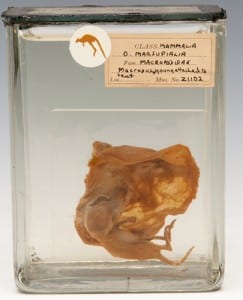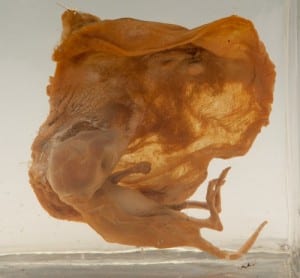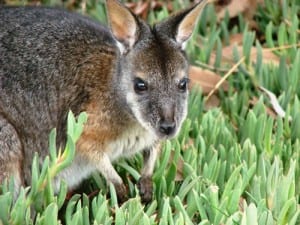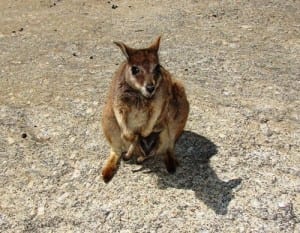Specimen of the Week 195: The Kangaroo Joey Preserved on a Teat
By Jack Ashby, on 6 July 2015
For the past fourteen weeks a kangaroo has been the most celebrated object in the Grant Museum, but it was not part of our collection, nor was it a zoological specimen. Europe’s first painting of a kangaroo, from 1772 by George Stubbs left us just last week. It had been the centrepiece of our Stange Creatures exhibition and now it is continuing its nationwide tour from the National Maritime Museum*. I have argued it is one of the most important artworks in the history of British exploration.
Now that it’s gone, I would like to shine the spotlight on a kangaroo that does “live” here at the Grant Museum. Although it also featured in the exhibition, I suspect it’s recently been feeling somewhat overshadowed by its 2-dimensional counterpart. This week’s Specimen of the Week is…
**The Kangaroo Joey Preserved on a Teat**
1) Baby steps
The newborn kangaroo is an incredible thing. Although kangaroos grow to 85kg in weight and over 2m long, they are born the size and shape of a jelly bean, weighing 0.8 grams. This jelly bean however, despite limited internal development, has fully functioning forelimbs and lips, which it uses to make the long climb largely unaided from the birth canal through the mother’s fur uphill to the pouch, whereupon it attaches to a teat.
2) Bringing up baby
As such, marsupial reproduction is characterised by a very brief period of foetal development in the womb, followed by a long period of development suckling milk on the teat. This is in stark contrast to the more popular (numerically) way of being a mammal, which is practiced by us placental mammals. Placentals have a long period of development in the womb, which is finished by a short period of development suckling milk on the teat. In the case of grey kangaroos, the young spends just 36 days in the womb, spends eight months without leaving the pouch at all, permanently moves out at 11 months, but continues to suckle (by sticking its head in from outside) for 18 months.
3) “Contrary to the general laws of nature”
This is how Lieutenant Watkin Tench described the kangaroo. Tench travelled with the First Fleet, which established the British Australian colony at Sydney Cove in 1788. He was amazed that such large kangaroos grew from the tiny joeys he found in their pouches. He wrote that joeys “descend from the belly into the pouch, by one of the teats” – that they emerged directly from the nipple rather than the vagina. Quite how a wild animal could contravene the “laws of nature” is a philosphical paradox that appears to have escaped Tench, but it’s not a surprising perspective if indeed nipple-birth were the true way of kangaroo reproduction.
This misconception started with the very first description of an Australian mammal by a European. Dutchman Francisco Pelsaert encountered Tammar wallabies on the Houtman Abrollos islands, 80km west of modern day Geraldton, WA in 1629. Despite having survived a horrific shipwreck and mutinous bloodbath, he still took the time to describe the wildlife:
“there are a large number of Cats… Their generation or procreation is Very Miraculous, Yea, worthy to note: under the belly the females have a pouch into which one can put a hand, and in that she has her nipples, where we have discovered that in there their Young Grow with the nipple in mouth, and we have found lying in it some Which were only as large as a bean, but found the limbs of the small beast to be entirely in proportion, so that it is certain that they grow there out of the nipple“
(This is one of many encounters with marsupials that pre-date Captain Cook’s landing in Australia in 1770 which I wrote about in the post: The earliest Strange Creatures: Europe’s first meetings with marsupials.)
It was not until 1830 that the marsupial birth and crawl to the pouch was correctly described, by Alexander Collie, setting the record straight.
4) Marsupials – the “half beasts”
The denigration of marsupials as something inferior, “contrary to the laws of nature” started with Tench at the foundation of the Australian colony, but it has been pervasive. It was a very long held view that marsupial reproduction was primitive, and altogether not as “good” as the “normal” way of doing things, like us placental mammals. Indeed the taxonomic term for placental mammals, Eutheria translates as “true beasts”, while the marsupial term Metatheria means “half beasts”.
In fact pouch development is not evolutinarily primitive. It is an extremely sensible system in an unstable environment, such as Australia. If drought strikes and a mother can no longer feed both herself and her young, abandoning the baby could save her own life. This is much easier to do by reaching into a pouch and pulling the baby out than resorbing a large foetus in the womb. Marsupials give themselves the chance of surviving if things turn south, without having invested much in a young developing joey. As joeys get older, the energetic investment is greater and the likelihood of abandoment decreases.
5) That’s my nipple – I won’t share
Despite Pelsaert’s mistake, kangaroo reproduction is Very Miraculous**, Yea. Once a young kangaroo has ventured out of the pouch to begin exploring the world (we call them “young at foot”), they still stick their heads in to suckle. Nevertheless this means there is room in the pouch for another occupant. Kangaroos can have a fertilised egg waiting in a state of arrested development for the right time to give birth (it’s called embryonic diapause). Once the big joey frees up space in pouch, a new jelly bean is born and can climb in. It will attach to a different nipple to the one the young at foot uses, and that nipple will produce different milk. Kangaroos can provide differently constituted milks for differentluy aged joeys at the same time. Very clever.
Indeed they can have a fertilised egg in stasis in the womb, a tiny young permanently attached to the nipple in the pouch, and a larger young at foot still suckling all at the same time. If conditions are good they can run a constant conveyor belt of reproduction in this way. There’s nothing inferior about that.
*It’s now in the Captain Cook Memorial Museum in Whitby, it then goes to the Hunterian in Glasgow, then the Horniman Museum and Gardens before returning to the National Maritime Museum.
** Not actually a miracle, but a nifty result of millions of years of evolution.
Jack Ashby is Manager of the Grant Museum of Zoology (and curated the Strange Creatures exhibition)
References
McHugh, E 2006, 1606: An Epic Adventure, UNSW Press
Jackson, S & Vernes, K 2010, Kangaroo: portrait of an extraordinary marsupial, Allen & Unwin, Crows Nest, N.S.W.
Seymour, J 1980, The Small Marsupials, ECOS Vol. 26, CSIRO.
Van Dyck S, Strahan R, editors. The Mammals of Australia. 3rd ed. Sydney (Australia): Reed New Holland
4 Responses to “Specimen of the Week 195: The Kangaroo Joey Preserved on a Teat”
- 1
-
2
Free Museums | Travel Writing, Guides and Reviews wrote on 20 November 2015:

[…] to see. It can make you feel quite funny about your own head after looking at these in any detail. Joey. Not just any Joey either. No stuffed, fluffy cutie is this fellow. Rather, this is the preserved […]
-
3
Free Museums in London – Has Anyone Been To…? wrote on 25 August 2017:

[…] to see. It can make you feel quite funny about your own head after looking at these in any detail. Joey. Not just any Joey either. No stuffed, fluffy cutie is this fellow. Rather, this is the preserved […]
-
4
Free Museums in London – Has Anyone Been To…? wrote on 3 June 2020:

[…] Joey. Not just any Joey either. No stuffed, fluffy cutie is this fellow. Rather, this is the preserved body of a very young Joey, still attached to the mothers nipple in the pouch. It’s really creepy. […]
 Close
Close






Nature never ceases to amaze, imagine the journey from womb to pouch for a muscular bean